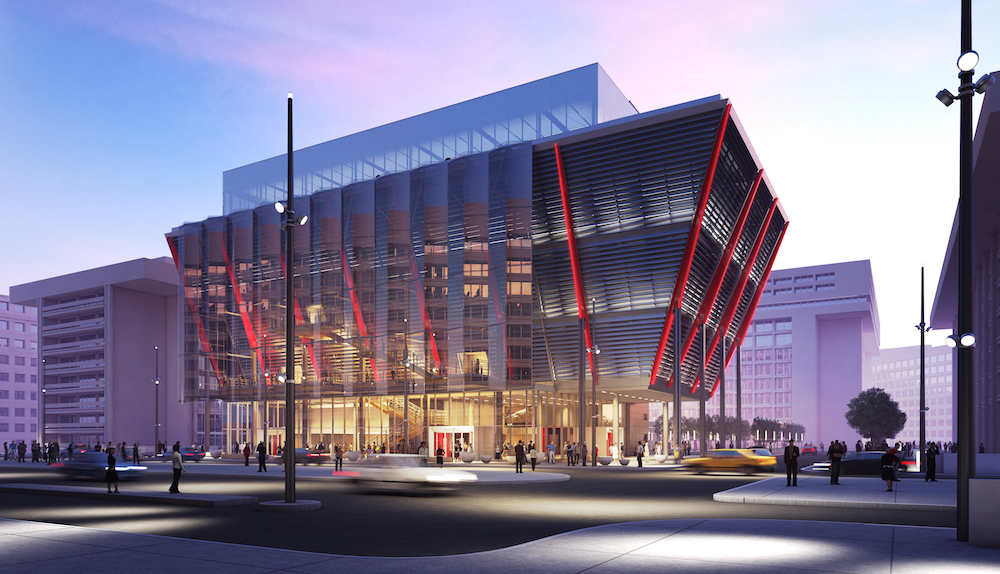The International Spy Museum in Washington, D.C., will be moving next year. If you want the new location of the museum you'll have to travel to a park in Partridge, Kan., where a package awaits you in a hollowed-out tree.
Just kidding! The museum says that it will relocate to a different spot in D.C., at L’Enfant Plaza between the National Mall and the Southwest Waterfront’s Wharf.
Construction has begun on the new 140,000-sf building. Designed by Washington, D.C.’s Hickok Cole Architects and London’s Rogers Stirk Harbour + Partners, the museum will have a glass veil wall in front of an enclosed black-box exhibition space, a setup that contributes to the museum’s “hiding in plain sight” theme.
The glass allows people to see activity inside and outside the museum, which the museum says will add energy to the L'Enfant Plaza. Considered a masterpiece when it opened, the plaza, which sits between a handful of commercial buildings with a shopping mall underneath, has been involved in renovation and demolition plans for years.
The building will have a theater and event spaces, and it will have more exhibition and educational spaces than its current location a few blocks north of the National Mall.
Opened in 2002, the International Spy Museum (SPY) contains exhibits that detail how spies recruit and train, make and break codes, and create false identities. Galleries of artifacts, photos, and videos show the history of espionage from Biblical times through the Cold War to today. The most popular special exhibit is Exquisitely Evil: 50 Years of Bond Villains, where visitors learn about the bad guys in the James Bond film series and how the franchise’s plots have adapted to changes in real-life spying.
The new museum will open in 2018 (Curbed Washington reports that the current museum’s lease doesn’t expire until the end of next year). The project’s developers are The Malrite Company and JBG Companies.
Related Stories
| Aug 11, 2010
Museum celebrates African-American heritage
The Harvey B. Gantt Center for African-American Arts + Culture recently completed construction on the Wells Fargo Cultural Campus in Charlotte, N.C. Designed by the Freelon Group, Durham, N.C., with Batson-Cook's Atlanta office as project manager, the $18.8 million project achieved nearly 100% minority participation.
| Aug 11, 2010
Design for Miami Art Museum triples gallery space
Herzog & de Meuron has completed design development for the Miami Art Museum’s new complex, which will anchor the city’s 29-acre Museum Park, overlooking Biscayne Bay. At 120,000 sf with 32,000 sf of gallery space, the three-story museum will be three times larger than the current facility.
| Aug 11, 2010
Thom Mayne unveils ‘floating cube’ design for the Perot Museum of Nature and Science
Calling it a “living educational tool featuring architecture inspired by nature and science,” Pritzker Prize Laureate Thom Mayne unveiled the schematic designs and building model for the Perot Museum of Nature & Science at Victory Park in Dallas. The $185 million, 180,000-sf structure is 170 feet tall—equivalent to approximately 14 stories—and is conceived as a large...
| Aug 11, 2010
Piano's 'Flying Carpet'
Italian architect Renzo Piano refers to his $294 million, 264,000-sf Modern Wing of the Art Institute of Chicago as a “temple of light.” That's all well and good, but how did Piano and the engineers from London-based Arup create an almost entirely naturally lit interior while still protecting the priceless works of art in the Institute's third-floor galleries from dangerous ultravio...
| Aug 11, 2010
The Art of Reconstruction
The Old Patent Office Building in Washington, D.C., completed in 1867, houses two Smithsonian Institution museums—the National Portrait Gallery and the American Art Museum. Collections include portraits of all U.S. presidents, along with paintings, sculptures, prints, and drawings of numerous historic figures from American history, and the works of more than 7,000 American artists.
| Aug 11, 2010
Silver Award: Please Touch Museum at Memorial Hall Philadelphia, Pa.
Built in 1875 to serve as the art gallery for the Centennial International Exhibition in Fairmount Park, Memorial Hall stands as one of the great civic structures in Philadelphia. The neoclassical building, designed by Fairmount Park Commission engineer Hermann J. Schwarzmann, was one of the first buildings in America to be designed according to the principles of the Beaux Arts movement.







